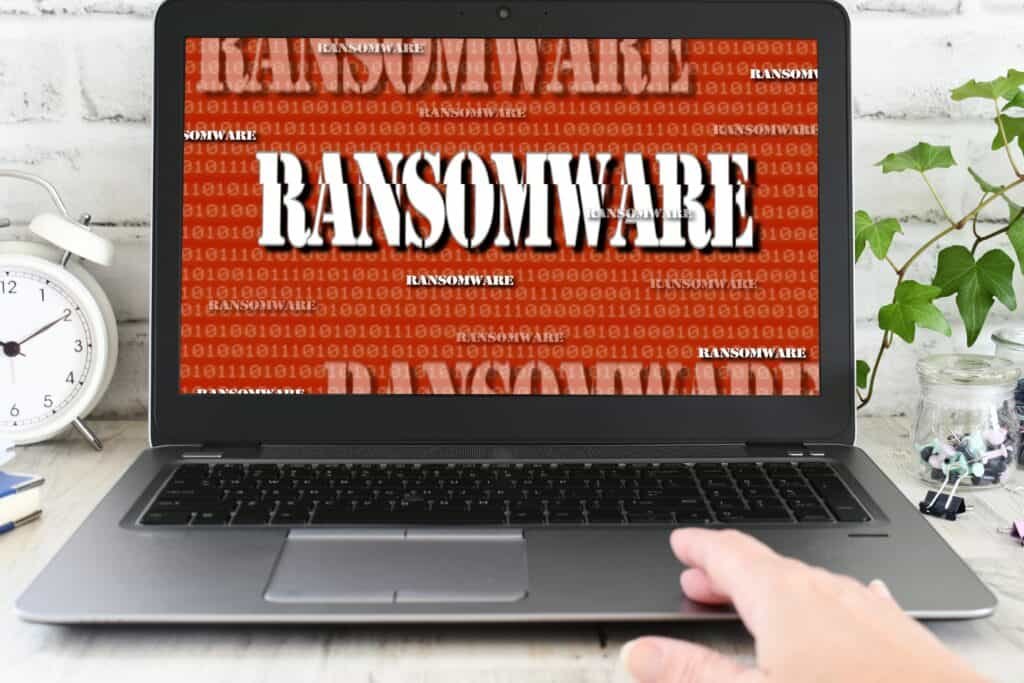Protect Yourself Now: How to Prevent Ransomware Attacks in 2024

We may earn a small fee from the companies mentioned in this post.
Imagine the devastating consequences of a ransomware attack: your company’s critical files encrypted, operations halted, and a hefty ransom demand waiting for you. This nightmare scenario can be averted with the right prevention strategies. In this blog post, you’ll learn about ransomware attacks, and how to prevent ransomware attacks.
We will explore the infection process, and effective methods on how to prevent ransomware attacks. By the end, you’ll have the tools and knowledge to build a resilient defence against ransomware and safeguard your valuable data.
Short summary
Protect yourself from ransomware attacks in 2023 by strengthening RDP security, utilising advanced threat protection, regularly updating operating systems and software, using anti-malware/antivirus software & enhancing data backup strategies.
Build a resilient network infrastructure with firewalls & unique access for added security.
Develop comprehensive security awareness training programmes to foster better cybersecurity knowledge and streamline incident response planning for rapid recovery.
Understanding Ransomware Attacks

Ransomware is a form of malicious software attack that restricts access to critical files or systems until a ransom is paid.
Typically delivered through social engineering tactics, such as phishing, ransomware attacks persuade the victim to click on a malicious attachment in an email. Over time, ransomware has evolved, and now malicious emails often have malicious attachments that demand payment through credit card or cryptocurrency.
The frequency and impact of ransomware attacks are alarming. In 2022, it’s estimated that ransomware attacks occur every 10 seconds. This highlights the importance of having a robust ransomware defence strategy to safeguard individuals and organisations from the potential loss of confidential information.
Remember, preventing a ransomware infection is essential, as paying the ransom does not always guarantee the return of the affected data.
The Ransomware Infection Process

Ransomware attacks follow three primary stages: infection, encryption, and ransom demands. Infection usually occurs through phishing attacks, which are the primary source of malware infections.
Once the ransomware infects the system, it encrypts the victim operating system’s files, carefully selecting them to guarantee system stability. Finally, a ransom note is delivered, with ransomware actors typically requesting a specific amount of cryptocurrency in exchange for gaining access to the files.
It’s important to note that paying the ransom doesn’t always ensure a happy ending. Upon payment, the ransomware operator typically provides a copy of the private key, a copy of the symmetric encryption key, and a de-cryptor.
However, there’s no guarantee that the decryption process will work, or that the attacker won’t simply demand more money. This emphasises the importance of prevention and having a solid defence and recovery strategy.
Essential Strategies for Ransomware Prevention

In this section, we will explore key methods to prevent ransomware infection, including strengthening Remote Desktop Protocol (RDP) security, implementing advanced threat protection, regularly updating your operating system, systems and software, deploying ransomware, and employing anti-malware and antivirus software.
By implementing these strategies, you’ll be well-equipped to defend against ransomware attacks and protect your valuable data.
Strengthening Remote Desktop Protocol (RDP) Security
Remote Desktop Protocol (RDP) is a protocol developed by Microsoft that allows users to access and manage remote computers over a network or the internet. However, leaving RDP ports open can make an organization susceptible to ransomware attacks that exploit these ports.
It’s essential to strengthen RDP security by restricting remote access to dependable hosts and utilising two-factor authentication to avert unauthorised access to the system and decrease the danger of ransomware attacks.
To ensure the security of your RDP and SMB ports, review the settings for both on-premises and cloud environments. Collaborate with your cloud service provider to disable any unused RDP ports. This will help protect your organisation and cloud services from the devastating consequences in ransomware event of a ransomware attack.
Implementing Advanced Threat Protection
Advanced threat protection solutions, such as email security, vulnerability management, application whitelisting, and endpoint security, can help mitigate the risk of ransomware attacks. Email security is essential.
Advanced features are necessary to protect against malicious threats such as malware and ransomware. Many email security solutions, however, lack these important features.
Whitelisting is an approach that permits only recognised software to be installed on company machines, preventing the installation of ransomware. Endpoint security products protect remote devices used by network users, security professionals, and system administrators, including laptops, smartphones, and servers, from malicious actions taken on the hypervisor.
By implementing these advanced threat protection solutions, you can significantly increase ransomware protection and reduce the risk of a ransomware attack.
Regularly Updating Operating Systems and Software
Maintaining (patching) operating systems and keeping your software up-to-date with auto-updates (where feasible) is essential. It is important to plug any security vulnerabilities to thwart exploitation and prevent malware infection. Not keeping systems and software up to date can have severe consequences.
The WannaCry ransomware attack, which focused on computers running outdated versions of Microsoft Windows, affected over 230,000 computers and caused significant disruption to numerous major corporations worldwide.
Activating auto-updates ensures that the latest security patches are applied automatically, helping to close security gaps and prevent threat actors from exploiting vulnerabilities. By regularly updating your systems, you can significantly reduce the risk of a ransomware attack.
Checkout our article on Preventing Viruses on your Computer
Employing Anti-Malware and Antivirus Software
Utilising anti-malware and antivirus software is essential for safeguarding computer systems from viruses, spyware, malware, Trojans detecting ransomware, phishing attacks, and other forms of malicious software.
These programmes can detect and block many viruses before they infect a computer, reducing the risk of various cyber threats, such as keyloggers, browser hijackers, Trojan horses, worms, rootkits, spyware, botnets, and ransomware attacks.
To guarantee the efficacy of anti-malware and antivirus software, users should consistently update their software, scan their systems for malicious software, and deploy a firewall to protect their systems from external threats.
By employing these security tools, you can reduce the risk of a ransomware or malware attack, and protect your valuable data.
Read our article on The Best Anti-virus products in 2023
Enhancing Data Protection and Backup Strategies

Following the 3-2-1 rule is a robust backup strategy that entails maintaining three distinct copies of data on two distinct storage types, with one copy stored in offline backups and an additional copy on an immutable cloud storage server. Ensuring that backup files are suitably safeguarded and kept offline or out-of-band is crucial to prevent both malware and ransomware attacks from affecting your backups.
Routinely testing backup processes is essential to ensure that your backups are functioning optimally and that your data can be restored in case of a ransomware attack. By enhancing your data protection and backup strategies, you can minimise the damage caused by ransomware attacks and ensure the continuity of your operations.
Building a Resilient Network Infrastructure

Network segmentation divides the network into multiple smaller networks, each with its own security controls, firewalls, and unique access. This helps to isolate the ransomware and prevent it from spreading to other systems, lowering the overall impact of an attack.
Implementing network segmentation can significantly reduce the risk of a ransomware attack and protect your organisation’s valuable data.
Endpoint security is a critical element for expanding businesses, as an increase in end-users leads to a heightened number of endpoints that need to be safeguarded. Strengthening endpoints by utilising endpoint security solutions, including zero trust solutions, can help protect your organization from ransomware attacks and keep your data secure.
Developing a Comprehensive Security Awareness Training Program

Security awareness training is critical in averting ransomware attacks, as end-users and employees are the most frequent entry points for cyber attacks. Possessing fundamental cybersecurity knowledge can significantly impact and even forestall attacks at the source.
Implementing a comprehensive cybersecurity training programme is essential for the prevention of cyber threats from malicious actors like ransomware and for the security teams by encouraging employees to adopt a proactive attitude towards cybersecurity.
Providing employees with robust security training practices, such as how to recognise and respond to phishing attempts, can help prevent ransomware attacks at the source. By educating your employees on basic cybersecurity knowledge, you can greatly affect and even prevent ransomware attacks.
Streamlining Incident Response and Recovery Planning

An incident response plan for a ransomware attack should include defined roles and communications to be articulated during an attack, as well as a list of contacts such as partners or vendors. Establishing an incident response plan is essential, as it assists organisations in recognising the potential threat and responding promptly and efficiently, minimising the possibility of a major incident.
A suspicious email policy is crucial for educating employees on how to handle emails of uncertain origin. This may involve forwarding the suspicious email attachments to the IT security team for further inspection.
By streamlining incident response and recovery planning, you can ensure that your organisation is prepared to manage and recover from a ransomware attack efficiently.
How to recover from ransomware attacks
Recovering from a ransomware attack can be a complex process, but with the right steps, you can mitigate the damage and restore your system. Here’s an overview on how to recover from ransomware attacks:
1. Isolate Infected Devices:
The first step in recovering from a ransomware attack is to isolate the infected devices. Disconnect them from your network to prevent the ransomware from spreading to other devices. This includes Wi-Fi, Bluetooth, shared network drives, or cloud storage services.
2. Identify the Ransomware:
Next, try to identify the type of ransomware you’ve been infected with. Some types of ransomware have been cracked by security researchers, who have then released decryption tools. Websites like No More Ransom (nomoreransom.org) provide free decryption tools for many types of ransomware.
3. Report the Incident:
Report the ransomware attack to your local law enforcement agency. They may be able to provide assistance or connect you with resources. You should also report the incident to your country’s cybercrime unit and to the Internet Crime Complaint Centre.
4. Remove the Ransomware:
To remove the ransomware from your system, you’ll need to use a reputable antivirus or antimalware programme. Some security software providers offer specific ransomware removal tools. Remember, removing the ransomware does not decrypt your files; it merely gets rid of the malicious software.
You may also consider restarting your computer in Safe Mode. In this mode, only the minimum required programs and services are loaded. If the ransomware loads its encryption module during the system start-up, Safe Mode can prevent it from doing so.
Use can also use a different, uninfected device to download a reputable ransomware removal tool. Some antivirus software providers offer specific tools for ransomware removal. Be sure to choose a tool that can handle the type of ransomware you’ve identified.
Install the ransomware removal tool on the infected device and run a scan. Once the ransomware is detected, follow the prompts to remove it. This process will remove the ransomware but remember, it will not decrypt your files.
5. Restore Your Files:
If you have a recent backup of your files, you can restore your system. Make sure the ransomware has been completely removed before restoring from a backup, or the backup files may become encrypted as well. If you don’t have a backup, you may need to consider data recovery services. Some professional data recovery services specialise in ransomware cases.
6. Strengthen Your Security:
After recovering from a ransomware attack, it’s important to strengthen your security to prevent future attacks. Keep your operating system and software up to date, use a robust security solution, regularly backup your data, and educate yourself and your team about the dangers of phishing emails and suspicious links.
Remember, the best defence against ransomware is a good offence. Regular backups, strong security, and user education can go a long way in preventing ransomware attacks.
Summary
In conclusion, protecting yourself from ransomware attacks in 2023 requires a multi-layered approach, encompassing prevention strategies, robust network infrastructure, effective backup strategies, and comprehensive security training.
By implementing these practices, you can significantly reduce the risk of a ransomware attack and ensure the security of your valuable data. As the ransomware variants and attacks become more sophisticated and prevalent, it’s crucial to stay vigilant and proactive in your defence.
Remember, the best defence is a strong offense, so don’t wait for an attack to happen—protect yourself now.
Frequently Asked Questions
How to prevent ransomware attacks?
To prevent a ransomware attack, we recommend utilising various security techniques such as intercepting proxies, internet and security software, gateways and safe browsing lists. By implementing these tools, you can protect your organisation’s data from malicious cyber attackers and reduce the risk of ransomware.
These techniques can help to ensure that your data is secure and protected from any malicious activity. They can also help detect any suspicious activity on a mobile device and alert you to any potential threats. Additionally, they can help to prevent any unauthorised activity.
Are ransomware attacks preventable?
Ransomware attacks can be prevented by following best practices such as regular patching and software updates, practicing caution when clicking on links or opening attachments, and regularly backing up data.
Taking these proactive security measures now will help keep organisations protected against potential ransomware threats.
How is ransomware prevented or removed?
To prevent and remove ransomware, it is recommended to use proxy interception, security gateways, and safe browsing lists. Additionally, it is important to ensure all software is up-to-date and employ anti-virus and malware protection systems on all of your devices.
By taking these precautionary steps, ransomware can be effectively avoided.
What is ransomware and how can we prevent ransomware?
Ransomware is an insidious cyber attack designed to extort money from individuals or organisations. By leveraging malicious code to encrypt sensitive files, criminals attempt to pressure victims into paying a ransom fee for a decryption key.
To avoid becoming a victim of ransomware, it’s important to practice safe online habits like using strong passwords and avoiding clicking on suspicious links or emails.
How important are data backups in preventing ransomware damage?
Data backups are crucial in preventing ransomware damage. If you have a recent backup of your files, you can restore your system to its previous state without paying a ransom. It’s important to ensure that backups are stored in a location that won’t be accessible to the ransomware.
Useful external links
- 7 Steps to Help Prevent & Limit the Impact of Ransomware – CIS Center for Internet Security
- How Can I Protect Against Ransomware? – CISA (.gov)
- Ransomware protection: How to keep your data safe in 2023 – Kaspersky
- How to Prevent Ransomware Attacks: Top 10 Best Practices – UpGuard
- Mitigating malware and ransomware attacks – NCSC.GOV.UK
With over three decades of experience in the heart of London’s financial sector, I have dedicated my career to the pursuit of robust cybersecurity practices and IT leadership. As a Certified Information Systems Security Professional (CISSP), Certified Information Security Manager (CISM), Certified Chief Information Security Officer (C|CISO), Certified Ethical Hacker (CEH), and Computer Hacking Forensic Investigator (CHFI), I bring a wealth of knowledge and expertise to the table.
My journey in the field of cybersecurity has not only been about personal growth but also about sharing my insights with others. As an international speaker, I have had the privilege of addressing audiences worldwide, discussing the importance of cybersecurity in today’s digital age. My passion for knowledge sharing extends to my work as an author and blogger, where I delve into the complexities of cybersecurity, offering practical advice and thought leadership.
In my role as a CISO and Head of IT, I have overseen the development and implementation of comprehensive information security and IT strategies. My focus has always been on creating resilient systems capable of withstanding the evolving landscape of cyber threats.
My Master’s degree in Cybersecurity has provided a solid academic foundation, which, when combined with my practical experience, allows me to approach cybersecurity from a holistic perspective.
I am always open to connecting with other professionals in the field, sharing knowledge, and exploring new opportunities. Let’s secure the digital world together.

